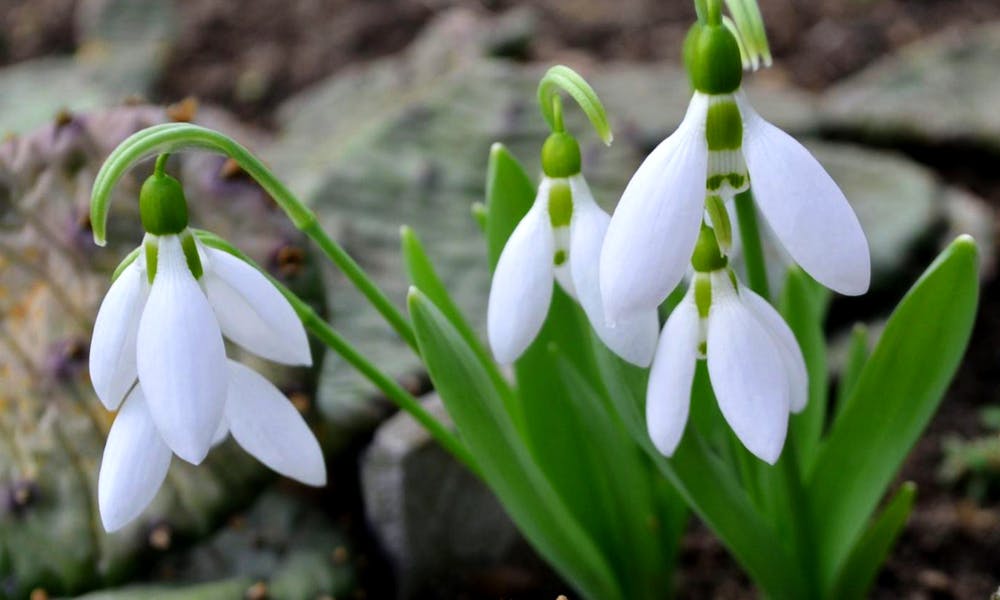Snowdrops are a beautiful and delicate beginning of spring. They bloom during the months of February through March often times while there is still snow on the ground. They give gardens an early start when most flowers are still dormant. In company with the carnation, snowdrops are the official flower for January birthdays.
As you read this, you can learn the following:
- Characteristics
- History
- Symbolism
- Planting and Care
Characteristics
The snowdrop is a perennial which is part of the amaryllis family. The small plant reaches a maximum height of 3 to 6 inches. It is the first of the spring flowers to bloom generally before or coinciding with the vernal equinox at the end of March. Snowdrops produce one small white flower which droops its head toward the ground. When the flower opens it has three inner petals that are covered by three outer petals. The head of the flower will collapse in freezing temperatures and reopen when the weather gets warmer.
The leaves of snowdrops are bluish-green and long and slender, much like blades of grass. They emerge from the bulb enclosed in a sheath. The position of the leaves to each other as they come out is based on the species of plant. The leaves may appear pressed against each other, or pressed against each other with the edges curled out, or one leaf is tightly rolled around the other. At one time this feature of the leaves was used to differentiate between the species but it proved to be unreliable and is no longer used.
History
Originally believed to be a wildflower native to Britain, the snowdrop is actually native to Europe and the Middle East. It was brought to Britain by the Romans. It is a small genus of about 20 species of plants in the Amaryllidaceae family. They have been known by other names in early history. However, it was Carl Linnaeus, a Swedish botanist, who named the snowdrop the Galanthus nivalis, “milk flower of the snow,” in 1753. It has been introduced into other areas outside of Europe and the Middle East where it has naturalized.
Myths and Legends
A Moldovan legend describes a fight between Lady Spring and Winter Witch; details show that at a point in the battle Lady Spring cuts her finger. The drop of blood melted the snow and a snowdrop flower grew. The pure white flower was a sign of Lady’s Spring’s victory over the Winter Witch.
A German folktale shows a gentler side to the snowdrop. At the beginning of time, Snow searched for a color to borrow. The elements admired flowers and their colors. When Snow asked and pleaded for one of the colors of the flowers, the flowers turned way denying Snow a color; they felt Snow was too cold and unpleasant. The snowdrop however felt sorry for Snow and offered it its color.
Snow accepted the gift and became white from that point on. To show its gratitude, Snow allowed snowdrops to bloom at the end of winter with Snow’s protection against snow and ice. Snow and snowdrops exist side-by-side as friends.
Symbolism
Snowdrops have many meanings and symbols associated with it. They can mean purity, innocence, and sympathy.
In Victorian England, if you sighted a snowdrop it was a sign of death and back luck. It was also considered back luck to pick the flowers and use them inside the home. It was believed that when you picked a snowdrop it negatively affected the quality of cow’s milk and discolored butter.
One of the reasons it was considered back luck is because it was found in many cemeteries and around gravesites. It has evolved to symbolize sympathy and consolation.
The white of the snowdrop symbolizes innocence and purity. Because it is the first flower to bloom at the end of winter and the beginning of spring, it also symbolizes hope.
Planting and Care
The snowdrop is one of the first flowers to bloom in the spring. It is visually interesting when mixed with other spring bulbs. The snowdrop will gradually spread over time to other areas of your garden. It is important to know that the snowdrop is toxic to all animals and humans. So do not use around children or pets. The good news is that deer and wildlife leave it alone.
To begin planting, find an area that receives partial shade to full sun. The plant thrives in many soil types and needs very little maintenance. You have many choices for locations that include under trees because the snowdrop blooms before most of the leaves of a tree sprout. Other choices include rock gardens and woodland gardens.
Snowdrop bulbs are sold undried and need to be planted as soon as possible after purchase.
Before planting be sure to put on a pair of gloves. Some gardeners have found they experienced skin irritation from handling the bulbs due to its toxic nature. Once you have chosen a location, loosen the soil and mix in compost and granular fertilizer. Break up any clumps of soil or compost. Mix it all together. Plant the bulbs 2 to 3 inches deep in groups of 25 with the flat base of the bulb down in the soil. Point the narrow tip upwards. Cover with soil.
After the plants bloom and mature, wait until the leaves turn yellow to remove them. This gives the plants the chance to store the nutrients they need for next year’s bloom. Over time snowdrops can develop large clusters. This is easily remedied by digging up the snowdrops and dividing the bulbs then replanting them.
Conclusion
The tiny snowdrop holds so much meaning and beauty, a garden just is not complete without them. They herald the beginning of spring with purity and innocence. Cut and put in a bud vase, they bring an elegant simplicity to any home. They are the perfect give when you want to offer sympathy and condolence.
